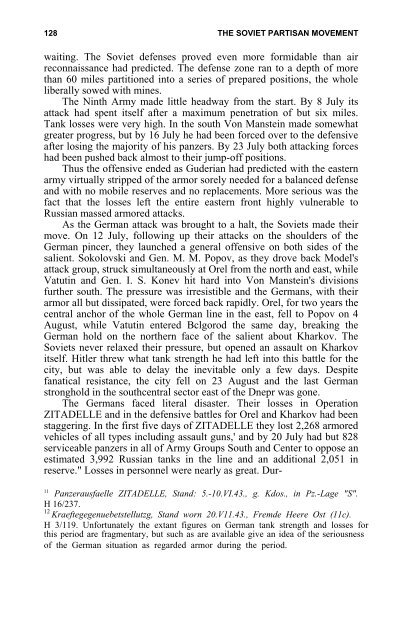the soviet partisan movement 1941-1944 by edgar m. howell
the soviet partisan movement 1941-1944 by edgar m. howell
the soviet partisan movement 1941-1944 by edgar m. howell
You also want an ePaper? Increase the reach of your titles
YUMPU automatically turns print PDFs into web optimized ePapers that Google loves.
128 THE SOVIET PARTISAN MOVEMENT<br />
waiting. The Soviet defenses proved even more formidable than air<br />
reconnaissance had predicted. The defense zone ran to a depth of more<br />
than 60 miles partitioned into a series of prepared positions, <strong>the</strong> whole<br />
liberally sowed with mines.<br />
The Ninth Army made little headway from <strong>the</strong> start. By 8 July its<br />
attack had spent itself after a maximum penetration of but six miles.<br />
Tank losses were very high. In <strong>the</strong> south Von Manstein made somewhat<br />
greater progress, but <strong>by</strong> 16 July he had been forced over to <strong>the</strong> defensive<br />
after losing <strong>the</strong> majority of his panzers. By 23 July both attacking forces<br />
had been pushed back almost to <strong>the</strong>ir jump-off positions.<br />
Thus <strong>the</strong> offensive ended as Guderian had predicted with <strong>the</strong> eastern<br />
army virtually stripped of <strong>the</strong> armor sorely needed for a balanced defense<br />
and with no mobile reserves and no replacements. More serious was <strong>the</strong><br />
fact that <strong>the</strong> losses left <strong>the</strong> entire eastern front highly vulnerable to<br />
Russian massed armored attacks.<br />
As <strong>the</strong> German attack was brought to a halt, <strong>the</strong> Soviets made <strong>the</strong>ir<br />
move. On 12 July, following up <strong>the</strong>ir attacks on <strong>the</strong> shoulders of <strong>the</strong><br />
German pincer, <strong>the</strong>y launched a general offensive on both sides of <strong>the</strong><br />
salient. Sokolovski and Gen. M. M. Popov, as <strong>the</strong>y drove back Model's<br />
attack group, struck simultaneously at Orel from <strong>the</strong> north and east, while<br />
Vatutin and Gen. I. S. Konev hit hard into Von Manstein's divisions<br />
fur<strong>the</strong>r south. The pressure was irresistible and <strong>the</strong> Germans, with <strong>the</strong>ir<br />
armor all but dissipated, were forced back rapidly. Orel, for two years <strong>the</strong><br />
central anchor of <strong>the</strong> whole German line in <strong>the</strong> east, fell to Popov on 4<br />
August, while Vatutin entered Bclgorod <strong>the</strong> same day, breaking <strong>the</strong><br />
German hold on <strong>the</strong> nor<strong>the</strong>rn face of <strong>the</strong> salient about Kharkov. The<br />
Soviets never relaxed <strong>the</strong>ir pressure, but opened an assault on Kharkov<br />
itself. Hitler threw what tank strength he had left into this battle for <strong>the</strong><br />
city, but was able to delay <strong>the</strong> inevitable only a few days. Despite<br />
fanatical resistance, <strong>the</strong> city fell on 23 August and <strong>the</strong> last German<br />
stronghold in <strong>the</strong> southcentral sector east of <strong>the</strong> Dnepr was gone.<br />
The Germans faced literal disaster. Their losses in Operation<br />
ZITADELLE and in <strong>the</strong> defensive battles for Orel and Kharkov had been<br />
staggering. In <strong>the</strong> first five days of ZITADELLE <strong>the</strong>y lost 2,268 armored<br />
vehicles of all types including assault guns,' and <strong>by</strong> 20 July had but 828<br />
serviceable panzers in all of Army Groups South and Center to oppose an<br />
estimated 3,992 Russian tanks in <strong>the</strong> line and an additional 2,051 in<br />
reserve." Losses in personnel were nearly as great. Dur-<br />
11<br />
Panzerausfaelle ZITADELLE, Stand: 5.-10.VI.43., g. Kdos., in Pz.-Lage "S".<br />
H 16/237.<br />
12<br />
Kraeftegegenuebetstellutzg, Stand worn 20.V11.43., Fremde Heere Ost (11c).<br />
H 3/119. Unfortunately <strong>the</strong> extant figures on German tank strength and losses for<br />
this period are fragmentary, but such as are available give an idea of <strong>the</strong> seriousness<br />
of <strong>the</strong> German situation as regarded armor during <strong>the</strong> period.
















